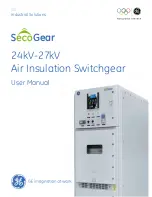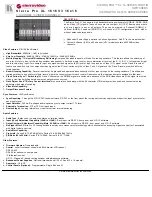
For more information visit: www.eaton.com
IB01602046E
Instruction Booklet
Page
18
Effective: July 2010
2-Position Contactor Based
Non-Automatic Transfer Switch
6.2.2 Transfer Switch Appears Inoperative (Non-Automatic
Electrical Operation)
Step 1:
Initially verify that there is no voltage on any source
(Source 1 or Source 2) inside the transfer switch.
Step 2:
Verify that all plugs and sockets are properly intercon-
nected.
Step 3:
Apply sufficient voltage and frequency on Source 1 (or
Source 2) and verify that correct system voltage appears
at Source 1 (or Source 2) side of the transfer switch.
Measure and confirm correct voltage at Source 1 (or
Source 2) lugs.
Step 4:
Verify that the voltage selection plug is in proper position
to match the system voltage.
Step 5:
Look for any obviously overheated components. Deter-
mine the cause and rectify, if possible. Replace defective
components after the cause is determined.
Step 6:
Verify that correct source available light is "ON" on the
front device panel.
Step7:
Turn 2-position selector switch to "Source-1" position (or
"Source 2" position) and verify that correct position indi-
cation light is "ON".
Following above steps, if the transfer switch does not transfer,
verify the wiring between the operating mechanism of the con-
tactor and front device panel.
Section 7: Maintenance
7.1 Introduction
In general, non-automatic transfer switch switch equipment is
designed to be relatively maintenance free under normal usage.
However, because of the variability of application conditions and
the importance placed on dependable operation by this type of
equipment, inspection and maintenance checks should be made
on a regularly scheduled basis. Since equipment maintenance
will consist mainly of keeping the equipment clean, the frequency
of maintenance will depend to a large extent on the cleanliness of
the equipment’s surroundings. If a significant amount of dust or
foreign matter is present, a more frequent maintenance schedule
should be followed.
It is suggested that visual inspections of the equipment be made
on a regular basis, not just during scheduled periods. Always be
alert for an accumulation of dirt in and around the structure; loose
parts; and/or hardware, cracks, and/or discoloration to insulation;
and damaged or discolored components.
7.2 Procedures
A suggested maintenance procedure is outlined in Table 5.
Table 5. Periodic Maintenance Procedures
WARNING
HIGH VOLTAGES ARE PRESENT IN AND AROUND NON-AUTOMATIC
TRANSFER SWITCH EQUIPMENT. BEFORE INSPECTING OR MAIN-
TAINING THIS EQUIPMENT, DISCONNECT THE LINE POWER FROM,
THEN LOCK OUT, IF POSSIBLE, THE NEXT HIGHEST DISCONNECT
DEVICE. FAILURE TO FOLLOW THIS PROCEDURE COULD CAUSE
SEVERE PERSONAL INJURY AND/OR DEATH.
STEP
ACTION
a. Make the non-automatic transfer switch equipment safe for inspection and/or
maintenance.
Disconnect the line power from equipment being serviced by opening the next highest disconnect device. Make
certain that any accessory control power is switched off by disconnecting all logic plugs.
b. Inspect the structure area for safety hazards or potential maintenance problems. Inspect the area, especially where switching device is installed, for any safety hazards, including personnel
safety and fire hazards. Exposure to certain chemical vapors can cause deterioration of electrical connections.
Inspect for accumulated dirt, loose hardware, or physical damage.
Examine the primary insulation for evidence of cracking or overheating. Overheating will show as discoloration,
melting, or blistering of conductor insulation, or as pitting or melting of conductor surfaces due to arcing.
Inspect the secondary control connections for damage and the control wiring for insulation integrity.
c. Inspect the power contactor for dust, dirt, soot, grease, moisture, or corrosion.
Remove dust, dirt, soot, grease, moisture, and corrosion contamination from the surface of the switching device
using a dry soft lint-free cloth, dry soft bristle brush, and vacuum cleaner. Do not blow debris into the power
contactor. If contamination is found, look for the source and fix the problem.
d. Check for material integrity, uneven wear, discoloration, or loose hardware.
Severe material cracking will require replacement and loose hardware will need to be tightened.
e. Check the terminals and connectors for looseness or signs of overheating.
Overheating will show as discoloration, melting, or blistering of the conductor insulation.
Connections that do not have signs of looseness or overheating should not be disturbed.
f. Contact Inspection Procedure
Carefully remove the arc chute clips using needle nose pliers. Remove the arc chutes to inspect the contacts.
Contact Eaton Care (1-877-ETN-CARE, Option-2) if the contacts have excessive wear. Reinstall the arc chutes
and arc chute clips, making sure the ends of the clips are fully seated in the grooves on the barriers.
g. Exercise the power contactor if it is not often exercised while in operation.
This will permit a “wiping” action by the contacts.
If the power contactor is used for frequent switching during normal operation, this step can be disregarded.
h. Return the non-automatic transfer switch equipment to service.
Make certain all barriers are in place and doors closed. Reapply secondary and primary power.







































